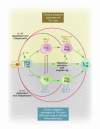IL-10-producing and naturally occurring CD4+ Tregs: limiting collateral damage - PubMed (original) (raw)
Review
IL-10-producing and naturally occurring CD4+ Tregs: limiting collateral damage
Anne O'Garra et al. J Clin Invest. 2004 Nov.
Abstract
Effective immune responses against pathogens are sometimes accompanied by strong inflammatory reactions. To minimize damage to self, the activation of the immune system also triggers anti-inflammatory circuits. Both inflammatory and anti-inflammatory reactions are normal components of the same immune response, which coordinately fight infections while preventing immune pathology. IL-10 is an important suppressive cytokine, produced by a large number of immune cells in addition to the antigen-driven IL-10-producing regulatory and the naturally occurring suppressor CD4+ T cells, which is a key player in anti-inflammatory immune responses. However, additional mechanisms have evolved to ensure that pathogen eradication is achieved with minimum damage to the host. Here we discuss those mechanisms that operate to regulate effector immune responses.
Figures
Figure 1
Layers of regulation of the immune response. At low levels of inflammation (A) both Foxp3+ naturally occurring Tregs and Foxp3– IL-10 Tregs inhibit CD4+ T cell proliferation through IL-10–independent, cell contact–dependent mechanisms. (B) Similar mechanisms may control immune responses to self antigens and autoimmune pathologies associated with low-level inflammation such as gastritis. (C) When strong inflammation occurs, with activation of APCs, effector molecules, such as IL-10 and TGF-β, secreted by Tregs are required to control CD4+ T cell responses. TLR, Toll-like receptor.
Figure 2
Cross-regulation of effector Th responses and feedback inhibition of naive T cell proliferation. IL-12 produced by the dendritic cell drives Th1 cells (IFN-γ). IL-4 produced by a variety of sources, including in some cases the naive T cell itself, drives Th2 cells to secrete cytokines (IL-4/IL-10). These effector subsets and the cytokines they produce or that drive them inhibit each other’s differentiation. Repetitive activation of effector Th cells with cognate antigen results in the differentiation of regulatory Th cells with inhibitory function via as-yet-unknown mechanisms. Proliferation of naive CD4+ T cells is controlled by inhibition of the antigen-presenting cell function of the DCs via both IL-10–dependent and IL-10–independent mechanisms. Green lines with arrows, activation/differentiation; red lines with block, inhibition.
Similar articles
- Thymic commitment of regulatory T cells is a pathway of TCR-dependent selection that isolates repertoires undergoing positive or negative selection.
Coutinho A, Caramalho I, Seixas E, Demengeot J. Coutinho A, et al. Curr Top Microbiol Immunol. 2005;293:43-71. doi: 10.1007/3-540-27702-1_3. Curr Top Microbiol Immunol. 2005. PMID: 15981475 Review. - CD4+CD25+ T(R) cells suppress innate immune pathology through cytokine-dependent mechanisms.
Maloy KJ, Salaun L, Cahill R, Dougan G, Saunders NJ, Powrie F. Maloy KJ, et al. J Exp Med. 2003 Jan 6;197(1):111-9. doi: 10.1084/jem.20021345. J Exp Med. 2003. PMID: 12515818 Free PMC article. - Aged regulatory T cells protect from autoimmune inflammation despite reduced STAT3 activation and decreased constraint of IL-17 producing T cells.
Sun L, Hurez VJ, Thibodeaux SR, Kious MJ, Liu A, Lin P, Murthy K, Pandeswara S, Shin T, Curiel TJ. Sun L, et al. Aging Cell. 2012 Jun;11(3):509-19. doi: 10.1111/j.1474-9726.2012.00812.x. Epub 2012 Mar 22. Aging Cell. 2012. PMID: 22372596 - Plasmodium falciparum-mediated induction of human CD25Foxp3 CD4 T cells is independent of direct TCR stimulation and requires IL-2, IL-10 and TGFbeta.
Scholzen A, Mittag D, Rogerson SJ, Cooke BM, Plebanski M. Scholzen A, et al. PLoS Pathog. 2009 Aug;5(8):e1000543. doi: 10.1371/journal.ppat.1000543. Epub 2009 Aug 14. PLoS Pathog. 2009. PMID: 19680449 Free PMC article. - Naturally-occurring CD4+CD25+ immunoregulatory T cells: central players in the arena of peripheral tolerance.
Piccirillo CA, Shevach EM. Piccirillo CA, et al. Semin Immunol. 2004 Apr;16(2):81-8. doi: 10.1016/j.smim.2003.12.003. Semin Immunol. 2004. PMID: 15036231 Review.
Cited by
- The divergent outcome of IL-4Rα signalling on Foxp3 T regulatory cells in listeriosis and tuberculosis.
Chia JE, Rousseau RP, Ozturk M, Poswayo SKL, Lucas R, Brombacher F, Parihar SP. Chia JE, et al. Front Immunol. 2024 Oct 17;15:1427055. doi: 10.3389/fimmu.2024.1427055. eCollection 2024. Front Immunol. 2024. PMID: 39483462 Free PMC article. - Kupffer Cells and Hepatocytes: A Key Relation in the Context of Canine Leishmaniasis.
Rodrigues A, Alexandre-Pires G, Valério-Bolas A, Nunes T, Pereira da Fonseca I, Santos-Gomes G. Rodrigues A, et al. Microorganisms. 2024 Sep 13;12(9):1887. doi: 10.3390/microorganisms12091887. Microorganisms. 2024. PMID: 39338560 Free PMC article. - Baseline biomarkers of efficacy and on-treatment immune-profile changes associated with bempegaldesleukin plus nivolumab.
Gogas H, Ravimohan S, Datta A, Chhibber A, Couselo EM, Diab A, Pereira C, Quéreux G, Sandhu S, Curti B, Khushalani NI, Taylor MH, Daniels GA, Spreafico A, Meniawy T, Van Den Eertwegh AJM, Sun Y, Arriaga Y, Zhou M, Long GV, Lebbé C. Gogas H, et al. NPJ Precis Oncol. 2024 Jul 19;8(1):150. doi: 10.1038/s41698-024-00641-7. NPJ Precis Oncol. 2024. PMID: 39025948 Free PMC article. - Molecular Pathogenesis of Ischemic and Hemorrhagic Strokes: Background and Therapeutic Approaches.
Maida CD, Norrito RL, Rizzica S, Mazzola M, Scarantino ER, Tuttolomondo A. Maida CD, et al. Int J Mol Sci. 2024 Jun 7;25(12):6297. doi: 10.3390/ijms25126297. Int J Mol Sci. 2024. PMID: 38928006 Free PMC article. Review. - The role of regulatory T cells in vitiligo and therapeutic advances: a mini-review.
Jin S, Wan S, Xiong R, Li Y, Dong T, Guan C. Jin S, et al. Inflamm Res. 2024 Aug;73(8):1311-1332. doi: 10.1007/s00011-024-01900-w. Epub 2024 Jun 5. Inflamm Res. 2024. PMID: 38839628 Review.
References
- Sundstedt A, et al. Immunoregulatory role of IL-10 during superantigen-induced hyporesponsiveness in vivo. J. Immunol. 1997;158:180–186. - PubMed
- Sundstedt A, O’Neill EJ, Nicolson KS, Wraith DC. Role for IL-10 in suppression mediated by peptide-induced regulatory T cells in vivo. J. Immunol. 2003;170:1240–1248. - PubMed
- Groux H, et al. A CD4+ T-cell subset inhibits antigen-specific T-cell responses and prevents colitis. Nature. 1997;389:737–742. - PubMed
- Roncarolo MG, Bacchetta R, Bordignon C, Narula S, Levings MK. Type 1 T regulatory cells. Immunol. Rev. 2001;182:68–79. - PubMed
Publication types
MeSH terms
Substances
LinkOut - more resources
Full Text Sources
Other Literature Sources
Medical
Research Materials

